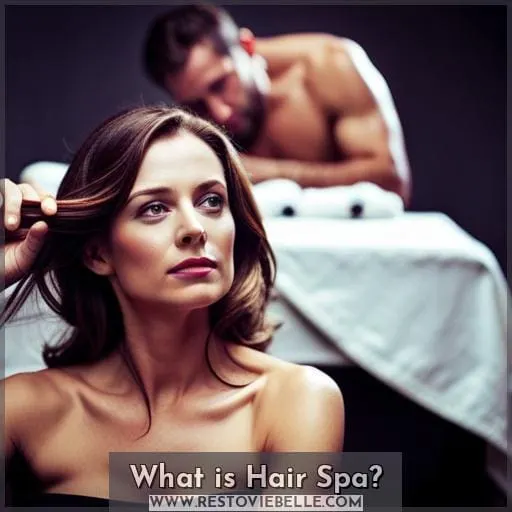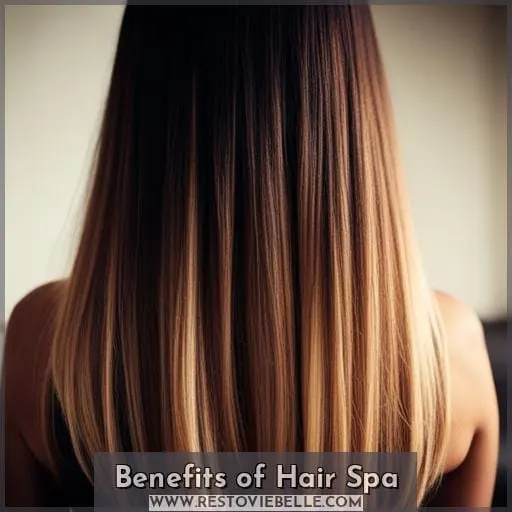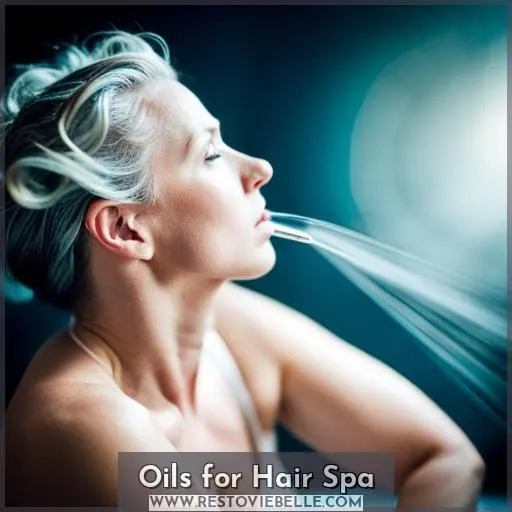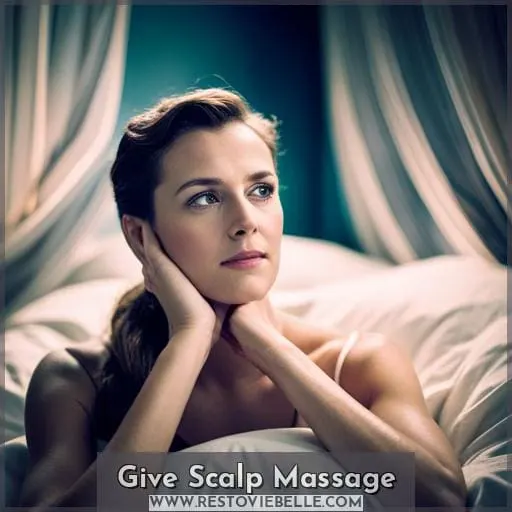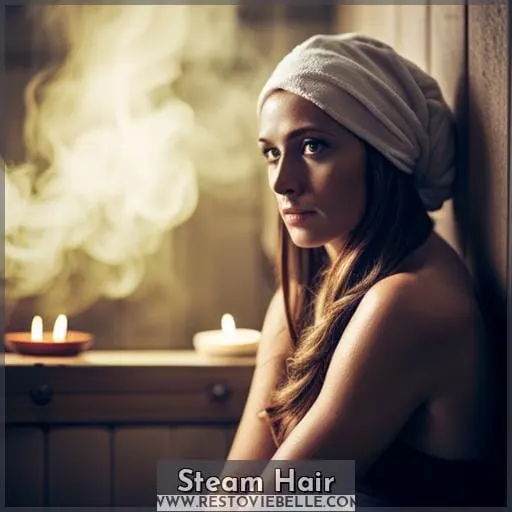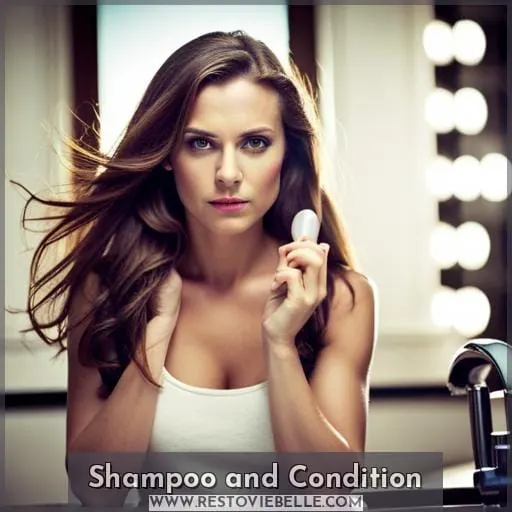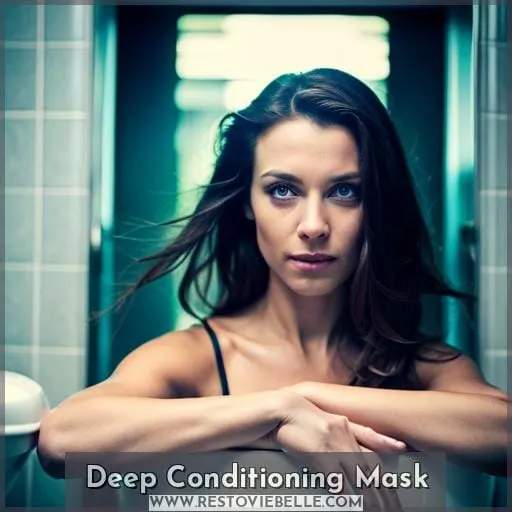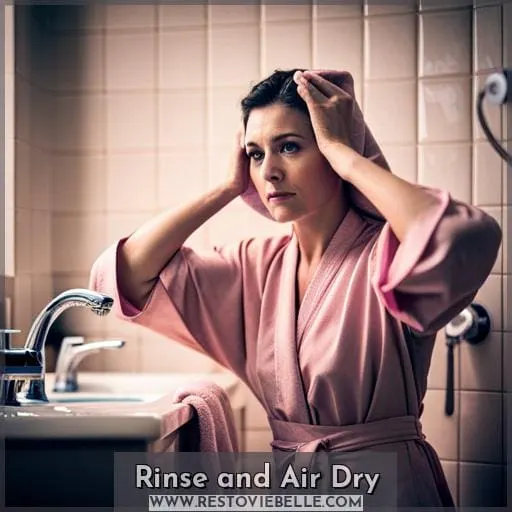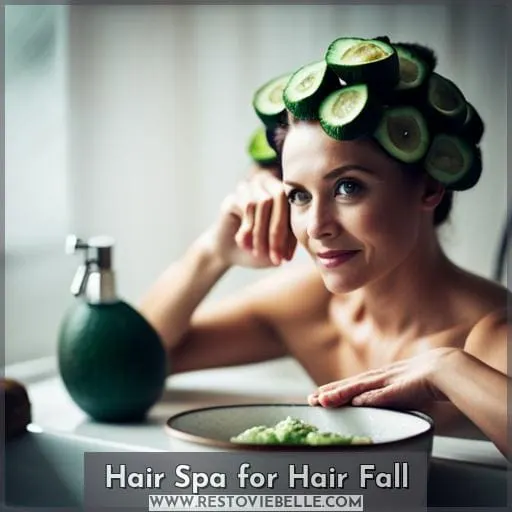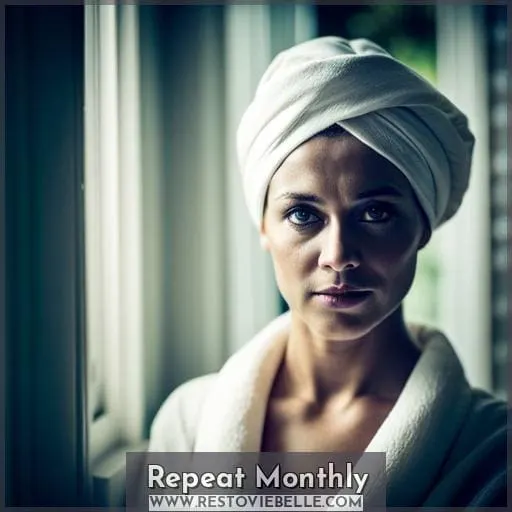This site is supported by our readers. We may earn a commission, at no cost to you, if you purchase through links.
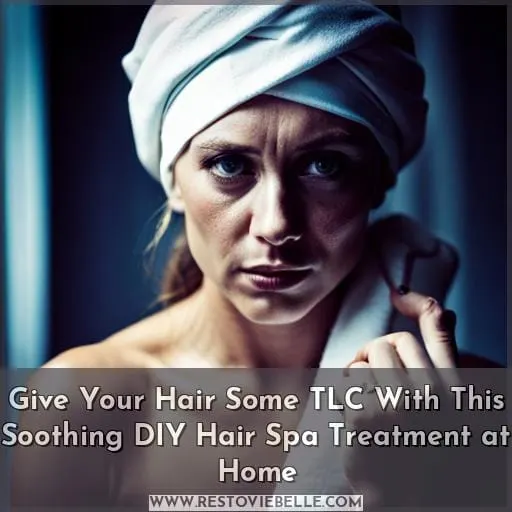
Let the fragrant oils seep deep to hydrate parched roots, restoring bounce and shine.
Allow steamy towels to gently pry open petals, enabling rich masks to permeate every strand with vitamins and moisture.
Emerging renewed, each silken tendril unfurls with health and vibrancy, ready to turn heads.
Now go ahead – give your tresses the indulgence they deserve.
Table Of Contents
- Key Takeaways
- What is Hair Spa?
- Benefits of Hair Spa
- Oils for Hair Spa
- Give Scalp Massage
- Steam Hair
- Shampoo and Condition
- Deep Conditioning Mask
- Rinse and Air Dry
- Hair Spa for Hair Fall
- Repeat Monthly
- Frequently Asked Questions (FAQs)
- Can I use a hair dryer instead of air drying my hair after a spa treatment?
- What essential oils can I add to the hair masks for extra nourishment?
- How long should I leave the hair mask on for maximum conditioning?
- If I have color-treated hair, will using oils and heat damage my color?
- Is it okay to brush my hair immediately after removing the hair mask or should I wait until it dries?
- Conclusion
Key Takeaways
- Massage scalp with oil before steaming hair to nourish follicles and loosen buildup
- Use a clarifying shampoo after steaming to remove oil residue thoroughly
- Apply a restorative hair mask for 15-20 minutes from roots to ends for deep conditioning
- Avoid heat styling after doing a hair spa to prevent damaging freshly nourished strands
What is Hair Spa?
You’re often treating your hair to a rejuvenating and nourishing hair spa to give it some extra TLC.
A hair spa is a specialized hair treatment that deeply conditions, restores moisture and shine, and repairs damage in your locks.
While salon hair spas use high-tech tools, you can create a relaxing, indulgent hair spa experience at home with ingredients like oils, masks, heat therapy and scalp massage.
Results are visible in the form of smoother, softer, more lustrous hair from root to tip.
After a hair spa, your hair will have more body and bounce.
The hair spa process moisturizes strands, boosts volume by unclogging follicles, reduces breakage and split ends.
Ultimately a hair spa breathes new life into your hair.
Benefits of Hair Spa
Keeping your hair and scalp healthy should be a priority, so allocate some time for a soothing DIY hair spa treatment at home. This will improve scalp health, reduce hair damage from styling, and boost shine and volume so your locks look their best.
Improves Scalp Health
A soothing hair spa ‘ll unclog your scalp pores and boost blood flow to nourish hair follicles from the root.
- Detoxify and remove buildup
- Reduce dandruff and itchiness
- Improve circulation for healthier hair growth
A scalp massage with hair spa cream then moisturizes while steaming further detoxifies for optimal scalp health.
Reduces Hair Damage
With a hair spa treatment, you’ll minimize hair damage resulting from heat styling, coloring, and environmental stressors.
Using a weekly hair mask helps hair grow stronger to prevent breakage, reduces frizz and split ends, and makes damaged hair soft again.
The nutrients in a hair spa or mask give your hair the nourishment it needs to bounce back from the daily wear and tear.
Boosts Shine and Volume
The hair spa treatment also boosts your hair’s shine and volume by deeply conditioning damaged strands and stimulating hair follicles. It removes product build-up and softens hair to prevent split ends, improve elasticity, reduce frizz and hair fall.
This at-home hair spa with hair serum and hair oil boosts hair growth for healthy, voluminous locks.
Oils for Hair Spa
One should select oils like olive, coconut, or almond when prepping for a soothing DIY hair spa. These oils are rich in fatty acids and nutrients that nourish hair follicles and improve scalp health.
Avocado oil is an ideal choice with its vitamin E and monounsaturated fats. It moisturizes dry strands and stimulates growth. Combine two tablespoons avocado oil with one egg yolk for an ultra-hydrating hair mask.
Olive oil coats each strand to seal in moisture. Mix with hair conditioner and massage onto scalp before showering.
Coconut oil penetrates hair shafts to soften and detangle. The lauric acid removes buildup so hair feels clean.
Castor oil thickens thinning hair thanks to ricinoleic acid which boosts circulation.
Whichever oil you choose, shampoo thoroughly after the hair spa to lift away excess oil. Oiling before showering allows the actives to penetrate best during a soothing at-home hair spa.
Give Scalp Massage
Massage your hair and scalp with oil to stimulate blood flow before steaming.
Use any hair oil of your choice – olive oil, sweet almond oil, coconut oil, etc. are great options.
Use your fingertips to massage the oil into your scalp in circular motions. Be gentle and take care not to pull or tug on your hair.
- Loosen and lift dirt and residue from scalp
- Stimulate blood circulation to hair follicles
- Provide essential nourishment to hair strands
This scalp massage technique helps with conditions like dandruff and frizzy hair. It’s an invigorating part of an at-home hair spa that you can’t quite recreate at a salon. The scalp massage ensures you address hair care issues right from the roots. Your hair will feel cleansed, volumized and hydrated after the complete DIY spa treatment.
Steam Hair
Steaming is an invigorating step in your at-home hair spa.
After massaging warm oil into your scalp, wrap your hair in a towel soaked in hot (not boiling) water.
Wrap your hair tightly to trap the steam. Use a clip to secure if needed. Let the steam work its magic for 10-15 minutes.
| Steam Duration | Frequency | Water Temperature | Towel Tightness |
|---|---|---|---|
| 10-15 minutes | Monthly | Quite hot, not boiling | Snug but not tight |
The steam opens your pores to feed nutrients deep into your hair follicles for long lasting nourishment.
Now your locks are prepped for a clarifying shampoo to remove oil and conditioner to boost shine and moisture retention.
Shampoo and Condition
After steaming, shampoo your tresses with a gentle, sulfate-free shampoo to wash away the oil.
- Look for shampoos labeled sulfate-free to avoid stripping oils.
- Opt for a moisturizing, gentle cleanser.
- Focus shampoo mainly on your roots and scalp.
Rinse with cool water to close cuticles and boost shine. Follow with a nourishing deep conditioner. Generously coat mid-length to ends, then clip hair up and leave on for 10-15 minutes. The deeply penetrating formula will strengthen strands and improve elasticity. Rinse out thoroughly.
Lastly, comb a leave-in conditioner through damp hair for lasting softness and to protect against styling damage.
Deep Conditioning Mask
After steaming your mane, it’s time to treat it to a nourishing deep conditioning hair spa mask for 15-20 minutes.
Choose a premade deep conditioning mask or make your own using hair spa ingredients like avocado, honey, olive oil, yogurt, and eggs. The healthy fats, proteins, and nutrients in these ingredients penetrate damaged hair cuticles to deeply moisturize strands.
Assemble any hair spa tools you need like a shower cap or heat cap to trap in warmth.
Apply a generous layer of mask across damp hair from roots to ends.
Let it soak in for 15-20 minutes before rinsing out.
For best hair spa results, aim to deep condition monthly. Regular use yields multiple hair spa benefits like reversing dryness, minimizing split ends, boosting shine, and reducing breakage over time.
Treating your tresses to some extra TLC with a reparative mask ensures you reap the full rewards of an at-home hair spa day.
Rinse and Air Dry
You’ll want to rinse your hair with a mild shampoo after the deep conditioning mask and let your locks air dry rather than towel drying or blow drying them.
Avoid heat styling your hair after a hair spa, as this can cause damage to hair that was just nourished.
Don’t brush your hair while wet, as wet hair is more prone to breakage. Instead, gently wrap your hair in a towel to absorb excess moisture.
When hair is halfway dry, use a leave-in conditioner to provide extra nourishment, detangle strands, and boost shine.
Avoid washing your hair daily, as this strips the natural oils. Give your mane a break in between shampoos and conditioners to retain moisture and preserve the results of your at-home spa treatment for luscious, healthy locks.
Letting hair air dry naturally is best after a hair spa so those rejuvenated strands can revel in the moisture without disruption.
Hair Spa for Hair Fall
9 One way you’ll beat hair fall is by indulging in monthly hair spas. These spa treatments nourish hair follicles and stimulate growth to reduce shedding.
Prepare by gathering ingredients like eggs, olive oil, honey, and avocados depending on your hair type.
Section your hair and massage the homemade mask into your scalp before steaming with towels or a shower cap for 10-15 minutes.
Rinse thoroughly with cool water and a sulfate-free shampoo. Repeat this hair spa monthly, documenting with before and after photos. Over time, you’ll have less hair in your brush and see new growth. Photos will reveal thicker, shinier locks thanks to strengthened strands and unclogged follicles.
Hair spas reverse damage from styling, environment, and hormones to revive hair growth.
Repeat Monthly
To maintain healthy and nourished hair, it’s recommended to repeat this DIY hair spa treatment once a month.
- Avoid using heat styling tools and gently dry hair with a towel
- Use a no-rinse gentle shampoo and lukewarm water
- Wrap hair in a hot towel after oiling for 5-10 minutes
Treating your hair to some extra nourishment regularly will help boost shine and strength over time. Going longer than a month between treatments can allow damage to accumulate again.
Giving your locks a little TLC doesn’t require anything fancy. Using ingredients from your kitchen and some simple techniques, you can pamper your hair right at home. Be sure to avoid heat styling and handle hair gently after the treatment. Letting it air dry naturally ensures those conditioning oils have time to work their magic.
Frequently Asked Questions (FAQs)
Can I use a hair dryer instead of air drying my hair after a spa treatment?
No, it’s best to avoid hair dryers after a spa treatment.
Letting your hair air dry allows the natural oils and conditioners applied during your treatment to soak in and properly moisturize each strand.
What essential oils can I add to the hair masks for extra nourishment?
Try adding rosemary, lavender, or peppermint oil for their nourishing properties.
How long should I leave the hair mask on for maximum conditioning?
For best results, leave the hydrating hair mask on for 15-20 minutes before rinsing.
This allows the natural oils and nutrients to be fully absorbed into your hair and scalp, providing maximum conditioning, silkiness, and shine.
Don’t leave on much longer or hair may become overly moisturized.
If I have color-treated hair, will using oils and heat damage my color?
Treat colored hair gently during a hair spa.
While oils provide nourishment, minimizing heat will help preserve vibrant color.
Focus on moisture and gentle cleansing.
Leave conditioning treatments on for less time.
Is it okay to brush my hair immediately after removing the hair mask or should I wait until it dries?
After removing the hair mask, wait before brushing – let those nourishing oils seep in fully first.
Impatient brushing can disrupt deep conditioning and lead to breakage.
Give your strands time to reconnect and regain elasticity after that luxurious treatment.
Conclusion
Pamper your hair with a soothing DIY hair spa treatment at home. By indulging in this nourishing routine, you can improve scalp health, reduce hair damage, and boost shine and volume.
Using the right oils and giving yourself a scalp massage will provide deep hydration and relaxation.
Steaming your hair, followed by shampooing, conditioning, and applying a deep conditioning mask, will further enhance the results.
Incorporate this hair spa treatment into your monthly routine to give your tresses the TLC they deserve.

